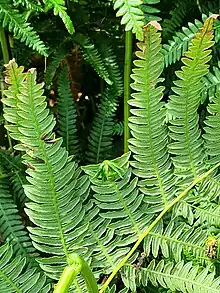| Chirosia grossicauda | |
|---|---|
 | |
| Scientific classification | |
| Domain: | Eukaryota |
| Kingdom: | Animalia |
| Phylum: | Arthropoda |
| Class: | Insecta |
| Order: | Diptera |
| Family: | Anthomyiidae |
| Genus: | Chirosia |
| Species: | C. grossicauda |
| Binomial name | |
| Chirosia grossicauda Strobl, 1899 | |
Chirosia grossicauda is a species of fly found in Europe. The larvae mine the lower rachis of bracken causing a swelling, known as a gall.
Lifecycle
A white maggot mines the central vein of the pinnule (a secondary division of a frond of bracken) causing the tip to roll downwards. The larva probably pupate in the gall, but are likely to fall out when the fronds wither and fall to the ground, pupating in the leaf litter. [1][2]
Parasites
Larva of Trybliographa ciliaris are endoparasitoid of the larvae of Chirosia grossicauda. [3]
Distribution
In Europe the fly is found from Ireland to Russia and from the Iberian Peninsula to Scandinavia.[4] It has also been recorded in South Africa.[5]
References
- ↑ Chinery, Michael (2011). Britain's Plant Galls. A photographic guide. Old Basing: WildGuides. p. 75. ISBN 978-190365743-0.
- ↑ Redfern, Margaret; Shirley, Peter; Bloxham, Michael (2023). British Plant Galls (Third ed.). Shrewsbury: FSC Publications. p. 232. ISBN 978-1-85153-284-1.
- ↑ "iNaturalist". Chirosia grossicauda. Retrieved 1 August 2023.
- ↑ Ellis, W N. "Chirosia grossicauda Strobl, 1899 on Pteridium". Plant Parasites of Europe. Retrieved 1 August 2023.
- ↑ "Chirosia grossicauda Strobl, 1899". Global Biodiversity Information Facility (GBIF). Retrieved 1 August 2023.
This article is issued from Wikipedia. The text is licensed under Creative Commons - Attribution - Sharealike. Additional terms may apply for the media files.